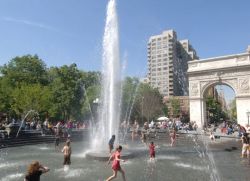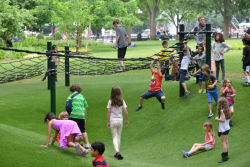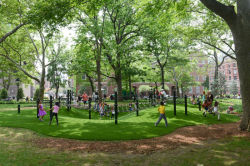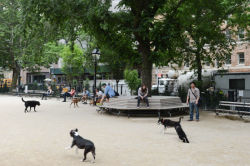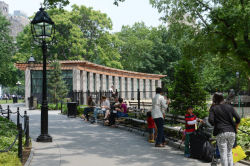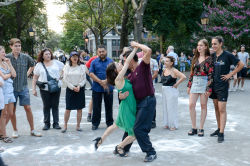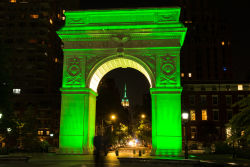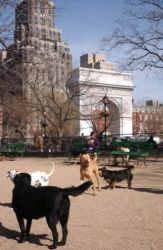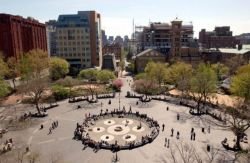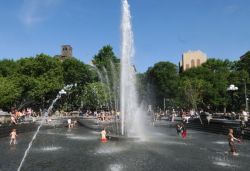Washington Square Park
View all monuments in NYC Parks, as well as temporary public art installations on our NYC Public Art Map and Guide.
Alexander Lyman Holley
| Artist: | John Quincy Adams Ward |
| Dedicated: | 1889 |
| Location: | 5th Avenue at Washington Place |
Artwork History
In Honor of Alexander Lyman Holley
Foremost Among Those Whose Genius and Energy
Established in America and Improved Throughout the World
The Manufacture of Bessemer Steel
This Memorial is Erected by Engineers of Two Hemispheres
Who is this monument dedicated to?
Alexander Lyman Holley (1832-1882) was born in Lakeville, Connecticut. His capacity for careful and discriminating observation and his notable drawing talents marked him as an engineer early in his life. Holley was the first student to graduate from Brown University in engineering, obtaining his Bachelor of Philosophy in 1853. He received fifteen patents and wrote several books and hundreds of articles. Known best for adapting the Bessemer process of steelmaking to U.S. needs, Holley had a brilliant and versatile mind. His work immediately brought rapid production to ironworks and rolling mills, significantly reduced steel prices, and enabled unprecedented growth in the industries that moved America forward, including railroads, bridges, and shipping.
He was practical, aiming to simplify, facilitate, save labor, and economize. Acknowledged as an authority by mechanical, mining, and civil engineers alike, Holley developed ideas and concepts that directly influenced both education and industry for decades beyond his death. Mechanical engineer Charles T. Porter (1826-1910) eulogized his character: “That beaming countenance with sparkling eyes, upon which it was such a joy to look...was the outward manifestation of a great soul, instinct with every feeling, that, in the appropriate words of another, can ennoble or can adorn our nature.”
How was this created?
When Holley died in Brooklyn at age 49, he was engaged in bringing the engineers of the world together by shaping the foundations for several professional societies. Three of these societies jointly raised funds and commissioned this memorial: the American Society of Mechanical Engineers (ASME) of which he was the “leading spirit” in its founding; the Institute of Mining, Metallurgical and Petroleum Engineers (AIME) of which he was a past president; and the American Society of Civil Engineers (ASCE) of which he was a past vice president. Dedicated on October 2, 1890, Holley’s memorial was given to the City of New York by “the engineers of two hemispheres” and was witnessed by an international group including societies from Germany and France.
John Quincy Adams Ward (1830-1910) sculpted the bronze portrait of Holley, which was cast by the Henry-Bonnard Bronze Company of New York in 1889. The bust is mounted on the central pillar of an elaborately carved tripartite pedestal made of Indiana limestone. The pedestal was designed by architect Thomas Hastings (1860-1929). This monument combines the architecture, sculpture, and ornament of the Beaux-Arts style.
In 1999 the Holley monument was conserved and a maintenance endowment was established through the Municipal Art Society’s Adopt-A-Monument Program.
Artwork Details
| Description: | Bust on a high central stele joined by screens to shorter side steles at right and left, the whole on a plinth resting on a semi-circular step |
| Architect: | Thomas Hastings |
| Materials: | Bronze, Indiana limestone |
| Dimensions: | Bust H: 3'6"; Central stele H: 9'; Total W: 10'3" D: 3'10" |
| Donor: | Engineering societies: ASME, AIME, and ASCE |
| Cast: | 1889 |
Inscription
HOLLEY /---/ BORN IN LAKEVILLE / CONN., JULY 20TH 1832 / DIED IN BROOKLYN, N.Y. / JANUARY 29TH, 1882 [---] IN HONOR OF / ALEXANDER LYMAN HOLLEY / FOREMOST AMONG THOSE / WHOSE GENIUS AND ENERGY / ESTABLISHED IN AMERICA / AND IMPROVED /THROUGHOUT THE WORLD / THE MANUFACTURE OF / BESSEMER STEEL / THIS MEMORIAL IS ERECTED / BY ENGINEERS / OF TWO HEMISPHERESPlease note, the NAME field includes a primary designation as well as alternate namingsoften in common or popular usage. The DEDICATED field refers to the most recent dedication, most often, butnot necessarily the original dedication date. If the monument did not have a formal dedication, the yearlisted reflects the date of installation.
For more information, please contact Art & Antiquities at (212) 360-8163.
Check out your park's Vital Signs
Clean & Safe
Green & Resilient
Empowered & Engaged Users
Share your feedback or learn more about how this park is part of a
Vital Park System







